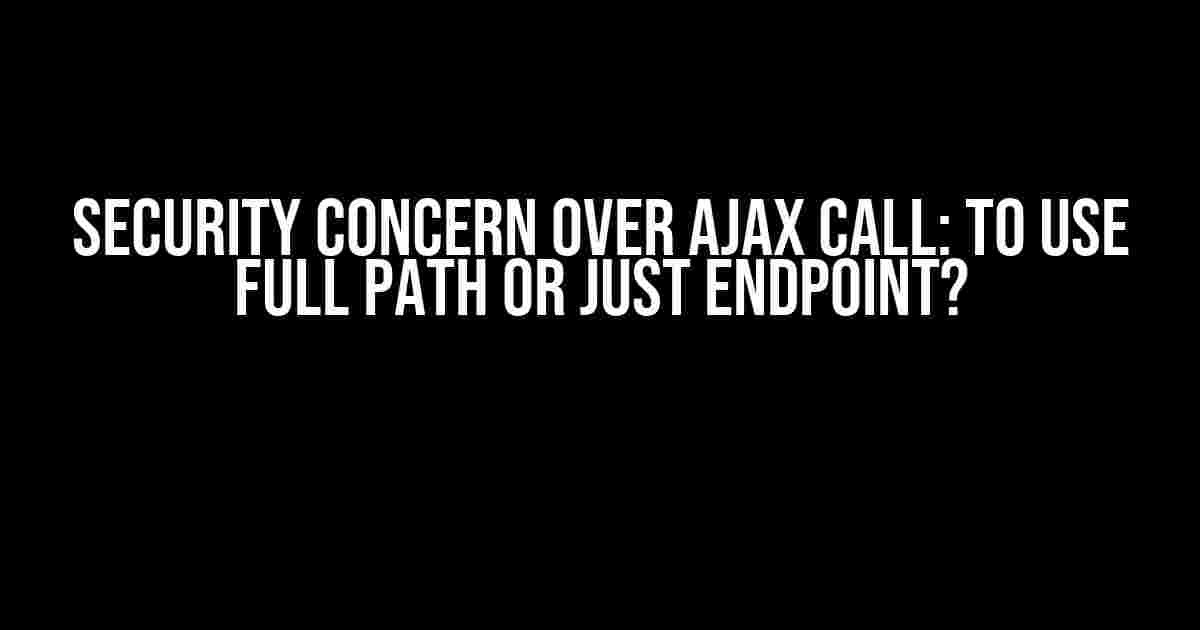When it comes to making AJAX calls, developers often face a dilemma: should they use a full path or just an endpoint? While it may seem like a trivial decision, it can have significant implications for the security of your application. In this article, we’ll delve into the world of AJAX calls and explore the pros and cons of using full paths versus endpoints. Buckle up, folks, and let’s dive in!
What’s the Difference Between Full Path and Endpoint?
Before we dive into the security implications, let’s quickly establish what we mean by “full path” and “endpoint.”
- Full Path: A full path refers to the entire URL of the resource being requested, including the protocol, domain name, port number, and path. For example:
https://www.example.com/api/data. - Endpoint: An endpoint, on the other hand, is the relative path of the resource being requested, without the protocol, domain name, or port number. For example:
/api/data.
The Case for Using Full Paths
So, why would you want to use full paths in your AJAX calls? Here are a few reasons:
- Specificity: By using a full path, you’re being explicit about the resource you’re requesting. This can help avoid ambiguity and ensure that the correct resource is retrieved.
- Flexibility: Full paths allow you to request resources from different domains or subdomains, which can be useful in scenarios where you need to fetch data from multiple sources.
- Ease of Debugging: When something goes wrong, having a full path in your AJAX call can make it easier to identify the issue, as the entire URL is provided.
Example of Using a Full Path in AJAX Call
<script>
$.ajax({
type: 'GET',
url: 'https://www.example.com/api/data',
success: function(data) {
console.log(data);
}
});
</script>
The Case Against Using Full Paths
While full paths offer some advantages, there are also some compelling reasons to use endpoints instead:
- Security Concerns: Using full paths can introduce security risks, as an attacker could manipulate the URL to request resources from a different domain or subdomain. This can lead to cross-site scripting (XSS) attacks or other types of security breaches.
- Portability: Endpoints are more portable, as they’re relative to the current domain or subdomain. This makes it easier to move your application to a different domain or environment without having to update all your AJAX calls.
- Readability and Maintenance: Endpoints are often shorter and more readable, making your code easier to maintain and understand.
Example of Using an Endpoint in AJAX Call
<script>
$.ajax({
type: 'GET',
url: '/api/data',
success: function(data) {
console.log(data);
}
});
</script>
Best Practices for Using AJAX Calls with Endpoints
To ensure the security and integrity of your application, follow these best practices when using endpoints in your AJAX calls:
- Use Relative URLs: Always use relative URLs for your endpoints, without including the protocol, domain name, or port number.
- Validate User Input: Make sure to validate any user input that’s used to construct the endpoint URL, to prevent XSS attacks or other security breaches.
- Use CSRF Tokens: Implement CSRF tokens to prevent cross-site request forgery attacks, which can exploit vulnerabilities in your AJAX calls.
- Keep Your API Keys Secure: If you’re using API keys or other authentication mechanisms, keep them secure and never hardcode them in your JavaScript files.
Conclusion
In conclusion, while full paths may offer some advantages, the security concerns and potential risks associated with their use make endpoints the better choice for most AJAX calls. By following best practices and using relative URLs, validating user input, implementing CSRF tokens, and keeping API keys secure, you can ensure the integrity and security of your application.
Remember, security should always be top of mind when developing web applications. Take the time to review your AJAX calls and make sure you’re using the most secure approach for your specific use case.
| Method | Pros | Cons |
|---|---|---|
| Full Path |
|
|
| Endpoint |
|
|
By now, you should have a clear understanding of the security concerns surrounding AJAX calls and the importance of using endpoints instead of full paths. Remember, security is an ongoing process, and staying vigilant is key to protecting your application and users.
Additional Resources
If you want to dive deeper into the world of AJAX calls and security, here are some additional resources to explore:
- OWASP AJAX Security Cheat Sheet
- MDN Web Docs: AJAX and JSON P security
- The Importance of AJAX Security in Web Development
Stay secure, and happy coding!
Here are 5 Questions and Answers about “Security Concern over AJAX call – use full path or just endpoint”:
Frequently Asked Question
When it comes to making AJAX calls, security is always a top concern. One common dilemma is whether to use a full path or just an endpoint. Here are some frequently asked questions to help you navigate this issue:
Is it more secure to use a full path or just an endpoint for AJAX calls?
Using a full path can be more secure because it specifies the exact location of the resource, making it harder for attackers to manipulate the URL. However, it’s essential to ensure that the full path is not hard-coded and is generated dynamically using a trusted source.
What are the risks of using just an endpoint for AJAX calls?
Using just an endpoint can increase the risk of URL manipulation attacks, as an attacker can easily modify the URL to access unauthorized resources. Moreover, if the endpoint is not properly validated, it can lead to path traversal attacks or access to sensitive data.
Can I use a relative path instead of a full path or endpoint?
Yes, using a relative path can be a good compromise between security and flexibility. A relative path is resolved relative to the current page’s URL, making it harder for attackers to manipulate the URL. However, ensure that the relative path is properly validated and sanitized to prevent any potential security issues.
How can I securely generate the full path or endpoint for AJAX calls?
To securely generate the full path or endpoint, use a trusted source such as a configuration file or a secure token. Avoid hard-coding the path or endpoint, and instead, use a dynamic approach to generate the URL. Additionally, validate and sanitize the generated URL to prevent any potential security issues.
Are there any other security considerations for AJAX calls besides the path or endpoint?
Yes, besides the path or endpoint, there are other essential security considerations for AJAX calls, such as validating user input, using HTTPS, implementing proper authentication and authorization, and protecting against cross-site scripting (XSS) and cross-site request forgery (CSRF) attacks.



